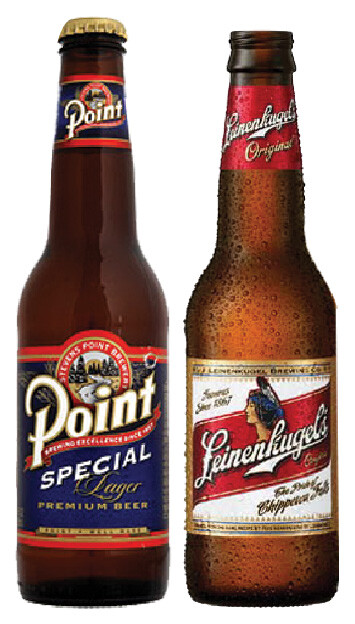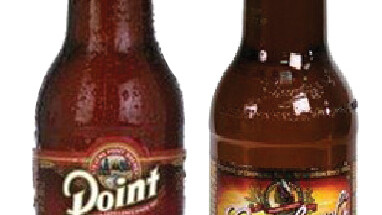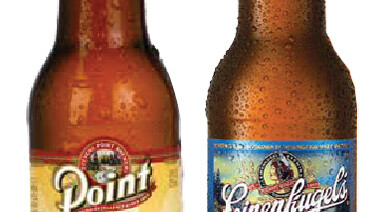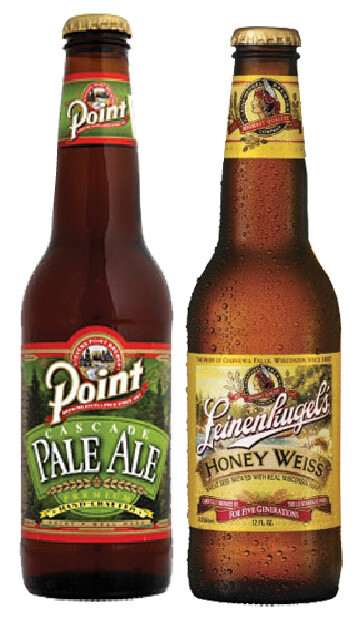Point vs. Leinie's
the pride of Stevens Point goes head-to-head with Chippewa’s finest
 Flagship Brews:
Flagship Brews:
Special Lager vs. Leinie’s Original
Leinie’s Original is always a solid choice among run-of-the-mill beers when you’re looking to drink something for long periods (bringing a case to a party, for instance). But you’ll find light beer drinkers opting away from it if it’s in a cooler next to Point’s Special Lager. Point’s brew is more closely related to Miller High Life in that respect. It’s a light-tasting, non-light beer that, among mixed company at The Joynt’s happy hour, is an obvious choice over draughts like Grain Belt or Berghoff. But drinkers dead set against drinking light are far more likely to turn to Chippewa’s finest.
 DARKER Brews:
DARKER Brews:
2012 Black Ale vs. Creamy Dark
I’m not typically a fan of dark beers (stouts, Belgian ales, etc.), but Creamy Dark is my favorite Leinie’s brew. It’s an anomaly in that it rides the fine line between light and dark, and can satisfy the tastes of both groups. I’d never tasted 2012 Black Ale before this article, so I was excited to see what Point has came up with. Theirs is an ale, inspired by the Mayan calendar’s ominous prediction of the end of the world. It is just as smooth as Creamy Dark, but doesn’t have as much of the roasty malt flavor that I love about the Leinie’s brew. In fact, if you drank 2012 blind and then opened your eyes, you’d be surprised to see a dark-colored beer in front of you. Fans of darker beers will much prefer Creamy Dark, while 2012 would be the choice of someone who doesn’t want a lot of flavor in their beer.
 AMBER Brews:
AMBER Brews:
Amber Classic vs. Classic Amber
Maybe it’s the fact that I’ve never been blown away by an amber, so I’ve come to expect little of them, but these were my least favorites in this taste test. For all of them, however, I turned to others to see what they thought, as well. But I had to rely on amber fans for their opinion on this, because these underwhelming beers tasted almost identical to me. Ambers are typically a little bitter from the crytal malt (which gives it the color), and the Leinie’s version gives me a little note of that in the aftertaste. Point’s, by comparison, has a fainter finish. What’s weird is beers with little flavor often end up being great for endurance drinking, but I can’t picture it for either of these. Both beers went over well with my other testers, but they ultimately preferred the Leinie’s slightly for “going down smoother.”
 WHEAT Brews:
WHEAT Brews:
Horizon Wheat Ale vs. Sunset Wheat
Wheat-based beers vary in taste so much that you never quite know what to expect. It could be a summery weissbier, a fruity witbier, or sour lambic. You just never know. I dove into Sunset Wheat, which had a sweet fruity finish that’s not too overwhelming. I could see this as a very refreshing summer beer. Once again, it’s aftertaste lasts much longer compared to the Point counterpart. Horizon Wheat is nothing that’ll blow you away, but I could drink it all day. After one taste of each, I’d probably say I prefer Sunset Wheat. But by the time they were gone I found myself wanting a few more Horizons, a beer that won the gold medal in the World Beer Cup’s wheat beer division last year. Point actually has another wheat beer called Nude Beach, and after sampling Horizon I think I’ll have to check that out.
 OKTOBERFEST Brews:
OKTOBERFEST Brews:
Oktoberfest vs. Oktoberfest
Being a state with strong German roots, Marzen-style Oktoberfest beers are notorious in Wisconsin. Especially in our region, with La Crosse and Chippewa Falls both having popular annual events under that header. I can’t pinpoint any particular taste to Point’s brew, which is odd since I expected an Oktoberfest to have a full-bodied flavor. This almost has a dry and bitter finish, but it’s subtle. By comparison, Leinie’s doesn’t have the dry or bitter, and what little flavor it does have is hints of nutty or oaky. Neither have the complexity I hoped for. This is a tough call. So I guess it comes down to which I could see myself chugging out of a stein for an entire weekend. If that’s the case, I’ll go with the slightly better mouthfeel of Leinie’s.
 LAST CALL:
LAST CALL:
Cascade Pale Ale vs. Honey Weiss
For a long time Honey Weiss was my go-to beer from Leinie’s. It’s a flavorful beer, like many of Leinie’s seasonals, but unlike brews like Berry Weiss or Summer Shandy, you can drink a six pack without getting sick of it. If you’ve never had it, it doesn’t taste sweet like honey (as the name suggests). It’s just a simple, refreshing, warm-day beer – a quality strengthened by the fact that’s it’s often served with a lemon. As I try Cascade, the first thing that hits my lips is the hops. And any fan of IPAs (India Pale Ales, beers known for strong hops) will love this beer. Like Honey Weiss, it’s a flavorful beer that you could drink a decent amount of (and the flavor strength of the hops lessens as you do). But when it comes down to it, Cascade is clearly a more divisive flavor to the general drinking populace than a crowd-pleaser like Honey Weiss.

